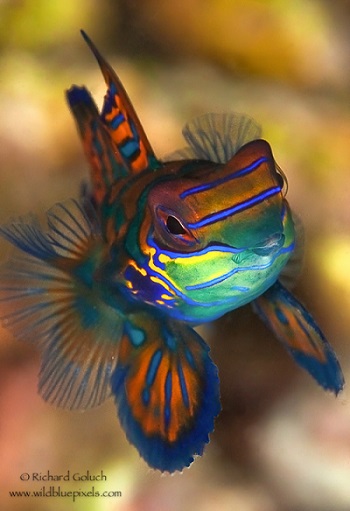Facts
We chose to research this specific organism, the mandarinfish, Synchiropus splendidus, mainly because of the phenomenal appearance of this fish. The vibrant colors that are displayed are such an amazing sight to behold. When looking at photographs of this fish it puts the eyes at ease to see such a beautiful creature. Though this fish may be a pleasant sight because of its remarkable color pattern, it is a very shy fish that is extremely hard to capture on camera. It only comes out of the crevices of the reef for little periods of time while dusk is approaching. To learn more about how this species interacts with others, click here.
The intricate and colorful pattern of the mandarinfish does not
fully develop until their second month (Patil 2006).

The mandarinfish is also an extremely small fish compared to other fish with which it shares the ocean water. Synchiropus splendidus can reach lengths up to a mere 9 cm (Sadovy, et al., 2005).
Mandarinfish are also unique because they are very popular in mariculture, due to the vibrant colors of their skin. They are a popular fish to purchase for people to put in their home aquariums. This helps support the local economies in the Philippines and Hong Kong (Sadovy, 2001). An interesting challenge that comes along with this beautiful species is that they are very hard to keep in captivity due to their specific feeding habits (Encyclopedia of Life). Most mandarinfish will only eat live food and will not eat frozen food like other marine animals in captivity. Since the food like copepods and amphipods are only available in established larger reef tanks it makes it hard for people starting out with new tanks to keep the mandarin fish from perishing by starvation (Life of Sea). To learn more about domesticated mandarinfish, visit the reference page.
Mandarinfish are also used for food in Asian countries (Sadovy, 2001).
Though mandarinfish are usually known to be peaceful and without conflict, occasionally the fish can be territorial and even fight among themselves or other species (Reef Keeping 2008).
To visit our reference list and other related websites, click here!
To go back to the home page, click here!